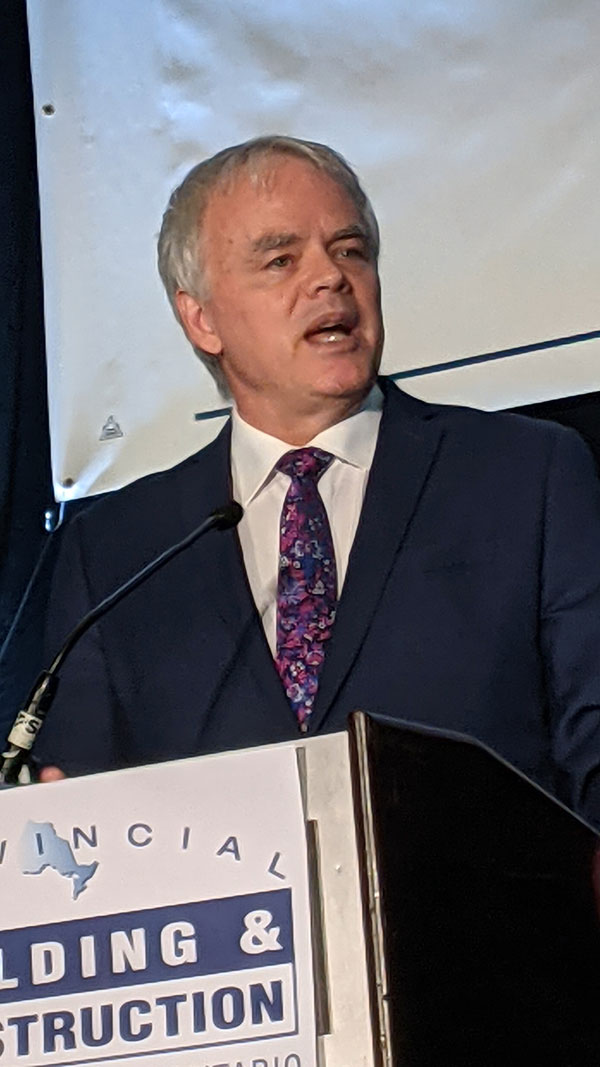Renowned labour economist Jim Stanford told an appreciative audience at the recent Ontario Building Trades convention the time has come for trades workers to demand significant wage hikes in the next round of collective bargaining.
Stanford, former Unifor economist, frequent television commentator and now director at the Centre for Future Work, told delegates attending the Provincial Building and Construction Trades Council of Ontario Building conference in Toronto Oct. 14 that unionized trades have played an important role in keeping Ontario’s economy buoyant during the pandemic.
But their wages have stagnated over the past five years with minimal real wage increases. So with labour productivity high and trades workers certain to plough any wage increases back into the economy, the time is right for decent wage increases, Stanford said.

“Your work as the construction unions, including your workers here, is to go and win very good settlements and help to build a stronger economy and a stronger society,” he stated. “To that I say, go get ‘em folks.”
In a recent report commissioned by the Building Trades, Stanford wrote while Ontario experienced the fastest and deepest decline in provincial GDP since the Great Depression during the first months of the pandemic, with over 15 per cent of Ontario workers losing their jobs, construction was an “oasis of stability.”
After adjusting to new COVID safety protocols, the sector quickly got back to work, with construction joining real estate and the financial sector as the only three sectors that grew in 2020.
By July 2020, construction employment in Ontario had regained its pre-COVID level, and the sector kept hiring; by the first half of 2021, construction employment was substantially higher than the same period in 2019.
Now, unlike in the U.S., job levels across the board have finally returned to the same level as before the pandemic.
“Construction and this ability of construction and the jobs in the construction sector were vital in helping that happen,” Stanford told the delegates.
“And it’s not just the quantity of jobs, it’s the quality of jobs, and thanks to the work of your unions, construction jobs, on average, have higher quality, better pay, better benefits, pensions, full-time hours, so over 91 per cent of construction workers were full time.”
Productivity among construction workers as measured by real value added for an hour worked increased 14 per cent in the past five years, far more than real wages increased.
“This is a great argument to go in and say, the industry is benefiting from our skilled productivity,” said Stanford. “That has to be recognized, that has to be compensated in the form of real wage increases.
“Moreover, you can argue that those real wage increases going forward are going to be beneficial not just for your members, of course, but for the economy as a whole. This is very important to position the union movement’s struggle not as just, ‘Give me more, give me more, give me more,’ but as, ‘This is the way we build a stronger, more balanced, more stable and more sustainable economy.’ ”
In the unionized construction sector, Stanford pointed out, over the past five years, nominal wages grew 1.9 per cent on average, but with inflation increasing on average 1.7 per cent per year, real wages grew just 0.2 per cent.
Compare the 1.9-per-cent annual growth, he said, to the economy-wide Labour Force Survey data, which shows an average of 3.4-per-cent increase in wages annually the last five years.
At this point the economy “still needs some gas in the tank” and it should be fair wages paid to unionized construction workers who will go out and spend it on housing and other commodities that will fuel the growth.
“Wages are the gas in the tank,” he said. “A five-per-cent wage increase for construction workers across the industry in Ontario would translate into $2 billion in additional consumer spending by those workers and 50,000 more jobs, and then downstream. So again, we’re supporting a broader and continuing economic recovery.”
Referring to the next round of collective bargaining in Ontario construction next spring, he added, “I’m not saying five per cent is the number you should ask for in the bargaining next year. I’m not saying five per cent is not the number you should ask for in your bargaining next year.”
Building Trades business manager Patrick Dillon later noted when he first joined provincial bargaining units decades ago, he found there was timidity in asking for wage hikes.
He recalled thinking, “I’m the new guy, how do you tell the 12 guys they haven’t done a very good job for the last 10 years.”
So he supported hiring Stanford ahead of the next round of bargaining to motivate and inspire the negotiators.
Follow the author on Twitter .











Recent Comments
comments for this post are closed